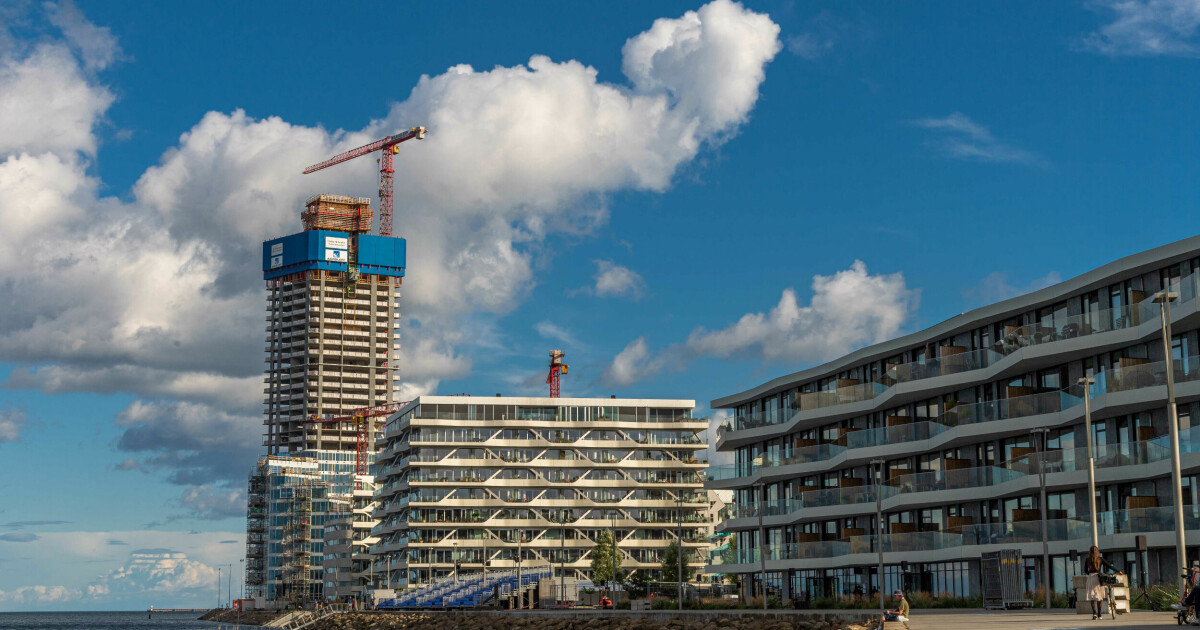Are skyscrapers more climate friendly?
More and more buildings are gradually rising into the air, and many contractors want to build skyscrapers.
They are often the subject of heated debate among the locals. But if you put on your climate glasses, does it make sense to build more skyscrapers? And can one find a formula for what the ideal building height is?
DTU Associate Professor Tove Lading has no doubt that we will have to move together in the future. More are expected to settle in the big cities.
– We must build much closer in a sustainable future, otherwise we use too much land. It does not work with detached houses if it is to be sustainable, says Lading, who is an associate professor at DTU Byg.
Scattered buildings are a bit environmentally friendly, it is among other things in place, which can go to forests and wildlife.
Lading has previously worked on large construction projects in Ørestad in Copenhagen. Here she helped to calculate what it would require of area if you had to build with the same population density as in the residential areas in Amager outside Copenhagen city.
The result was that it would not go up at all.
– That exercise illustrates that if you have to have a little nature left, we can not use detached houses. It is important to live close by.
Why build high?
One of the advantages of building taller and denser is that you can have infrastructure that more people share.
It often does not become necessary to have a car since it becomes easier with public transport, Tove Lading explains.
Another point is that it is more energy efficient with neighbors above and below – the heat loss will be less. In addition, you usually have fewer square meters that need to be heated.
At the same time, she emphasizes that all construction must be considered in the context of the surroundings.
– There are limits to how dense and high you can build, due to visibility, foundations and lighting conditions, Lading explains.
At the same time, turbulence forms around very tall buildings when it blows.
– Too tall buildings require space and energy for elevators. Then it also becomes more difficult to build verandas and provide access to outdoor areas.
No clear definition
But what does it really mean to build tall?
Tove Lading can not be exactly where the line goes.
– Skyscrapers are not very environmentally friendly. There is no reason to build so high, other than that it is spectacular, Lading believes.
– It creates shade, and it requires energy for lifts and a larger foundation, she continues.
Study: Ten floors is perfect
There is no precise model for the perfect height, according to the researchers.
But it is possible to find general trends, says Francesco Pomponi, a professor at Scottish Edinburgh Napier University.
Buildings of about ten storeys, which are built close together, can be the optimal choice, both in terms of energy and area in terms of an investigation in the journal Nature Urban Sustainability, which Pomponi is behind.
I study, the researchers used data from European cities and an algorithm to simulate 5,000 urban areas with different population regulations and rural areas.
They have carried out a life cycle assessment over 60 years in which the researchers compared emissions from fire types in development with either high or low population density and high or low building height.
They did not just look at the emissions while the building was in use. They also dealt with raw materials, transport, maintenance and renovation.
The conclusion is that buildings that are much more than 10-12 storeys high are less favorable, according to Pomponi.
– The problem is that you can not place skyscrapers so close. To build tall, you need heavier structures, thicker foundations and more distance – due to privacy, ventilation and daylight. This increases the climate footprint, Pomponi explains.
Requires more materials
When building very high, a number of extra loads are applied to the structure:
- When the building becomes heavier, a stronger foundation is required, and thus it can not always be built so densely.
- The lower floors of the building must withstand the weight of the additional floors.
All in all, it requires more aluminum and steel for the construction.
In a 2017 study from England the researchers concluded with a power consumption per. square meters is almost to half times larger in skyscrapers compared to blocks of around six floors.
So it is better with blocks like what you find in Paris and scattered skyscrapers.
At the bottom of the article, you can read more about five phases of life cycle assessments.
Important not to make mistakes
Tove Lading believes, however, that it will not be the material consumption that will be the tongue in cheek when it comes to building tall.
The most important thing is that you do not make mistakes in the building, and that the buildings can last a long time and be converted into new functions if the needs change.
– It is expensive, both financially and when it comes to emissions, to correct errors, and this is never taken into account in the life cycle analyzes you carry out. This is one of the most important things to be aware of, points out Lading, who is conducting a study in which researchers look at what it costs to correct a fault in a building in Greenland.
– It is office building which is done after a year and renovated again. If the building can adapt to new needs, it may make sense, but if it is heavy walls that can not be moved, it will become a problem, Lading continues.
Francesco Pomponi reckons that the overall life cycle assessment will be integrated into future urban planning so that one does not stare blindly at one parameter such as how many people the building can accommodate.
– The most important message in our study is the idea of harmonization and holistic urban planning in such a way that you not only look at the individual building, but also support it with a life cycle perspective, the professor explains.
Tove Lading finally points out that urban development and the needs of residents are important when assessing skyscrapers – otherwise it can quickly meet local opponents.
Reference:
Francesco Pomponi et al .: Decoupling density from height by analyzing urban life cycle emissions of greenhouse gases. Nature Urban Sustainability, 2021. Doi.org/10.1038/s42949-021-00034-w
Eirik Resch et al .: Impact of urban density and building height on energy consumption in cities. Energy Procedia, 2016. Doi.org/10.1016/j.egypro.2016.09.142
Christopher Drew and others: The environmental impact of high vs. low: A comparative study. International Journal of High-Rise Buildings, 2015.
High-rise buildings are much more energy-intensive than low-rise buildings, University College London
© Videnskab.dk. Translated by Lars Nygaard for forskning.no. Read the original case on videnskab.dk here.




